Victory Floatation
The Victory 21 owned by the University of Washington Sailing Club demonstrates the importance of floatation! ….and obviously it works….
The Sinking
Chris Mehlin, who was skipper, describes the events which lead up to the Victory going under:
I set sail, singlehanded, from the WAC at about eleven this morning in the Catalina 21. There was a stiff breeze (south, probably about 10-12 knots) and the sky was sunny. I was out on Lake Washington, just north of the 520 bridge, when the wind started to pick up. I nipped around Evergreen Point and took a bit of shelter in Yarrow Bay.
It rained, then the weather cleared a bit — I decided to head back to the WAC. This was a bad decision; the wind was fairly strong and the Catalina has tired sails and rigging. In addition, I’d noticed that the jib was beginning to tear. I should have left the boat at Yarrow Bay and come back for it when the weather calmed down. But I didn’t.
The wind picked up as I crossed back towards Webster Point, and it was slow going, especially as I was barely using the jib and pinching to ease strain on the main. The Catalina 21 does not have reefing points. As the wind shifted around and increased, I occasionally took a bit of water into the cockpit, but the cockpit drain seemed to be effective.
The boat was handling oddly, though. It seemed to be wallowing and had severe lee helm — surprising given how little work the jib was doing. In hindsight, the boat may have been taking on water — perhaps through the cockpit. I never opened the hatch to look below. The boat was also taking longer to recover when buffeted into a sharp heel.
Then she didn’t recover. She tipped to the side and made no motion to go back, instead rolling forward and, most sickeningly, DOWN. This happened very quickly.
I hope none of you ever has to witness your craft going down while you float next to it.
The bow sank, leaving the transom and the rearmost third of the boat high in the air. I extracted a handheld VHF (completely submerged but waterproof) from my backpack, which was tied to the boat, and climbed up on the transom. The boat did not sink any farther, and I began to try to gain the attention of the Sunday keelboat class via VHF. This attracted some attention from the Coast Guard, but once they were assured that lives weren’t in danger they relaxed.
About a half-hour later, I dropped from the transom onto a laser piloted by Rainer, who ferried me to Charlotte where I received donations of warm, dry clothing from the whole crew.
Prevention Considerations
Chris Mehlin continues:
There are always several missteps which allow an accident like this to happen:
01
The boat should probably not have left the WAC. She is not suited to high winds given the lack of reef points and fragile rigging and sails. While the wind was O.K. when she left, it was too strong later in the afternoon.
02
Human ballast. It has been suggested that if more people had been aboard, they could have sat on the weather rail and flattened the boat. While this is true, I daresay that you’d risk — no, probably guarantee — splitting sails at the very least. She just isn’t a high wind boat.
03
She should have been left at Yarrow Bay.
04
She has positive floatation, which is good, but the hatch cover was held in place only by gravity, making it impossible to seal. It seems likely that the cockpit was at least partially draining into the bilge. And, again, no reef points. All of which is probably O.K. for a low wind boat, but these become serious safety issues in higher winds.
The Recovery
The salvage operation is descrbed by Ross Fleming, Salvage Chief, Washington Yacht Club along with photos taken by Dave Banks:
The raising of the Catalina was way easier than I thought it would be.
We were very fortunate that the Harbor Patrol and Dave Banks & Andy Sack were able to tow it to such a convenient location just off the Magnussen Park boat launch. If it had been in deep water we probably would be filling out insurance claims right now.
I arrived at the WAC on Sun. afternoon to return the borrowed anchor and rodes that we used to anchor the Frigid Digit race committee to hear that the Catalina had been abandoned out on the lake.
By the time we were able to contact the patrol boat they reported that they had towed the boat to a point off Magnussen Park where it ran aground. Several of us drove out to investigate and plan the salvage.
We found the boat floating with the stern up about six feet out of the water and with the bow resting on the bottom sixty feet off the beach by the South picnic shelter.
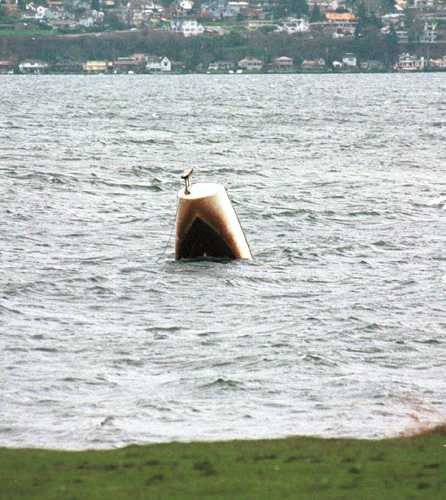
Julia was still in her wet suit from windsurfing and swam out to try and clean up the stray lines. Somebody saw her and called 911 without checking to see if she was OK so we were paid a visit by a fire engine and police car. The firefighters left but we had two patrol cars to supervise us. I swam out in my drysuit and set an anchor to keep the boat from drifting onto the beach or farther away. With the boat hopefully secured from further harm we discussed various salvage techniques and agreed to meet at the WAC at noon.
We met at the WAC to salvage the boat. Tom Schubert was driven to Wilson Marine to pick up the recently rebuilt little barge and drive it to the park. After we loaded our trucks with all the free fenders, spare line, and anchor rodes the rest of us drove out to the park although Matt Squires and I were delayed slightly when I got in a fender bender on Sand Point Way. Once we got to the park we had a meeting to discuss salvage options and safety considerations.
Several of our preferred methods were unavailable because we didn’t have access to a high volume air compressor to fill the boat or float bags. We agreed to concentrate on dragging the boat into a position alongside one of the launch ramp’s docks and worry about dewatering later if we were successful. We were concerned about people becoming hypothermic because it was so cold/windy and people were likely to get wet. We also discussed the risk of tensioned lines breaking and injuring anybody near them when the stretched line broke. Tom, Chris Mehlin, and I set out in the barge loaded with the large buoys and a long anchor rode. We planned on releasing the anchor that I set last night and running a line back to shore to pull the Catalina back in with. I dove to release the anchor I set Sunday afternoon and when I had it free the boat immediately started drifting down wind. It would have been better to have attached the line to shore before I freed it but I was able to tie a loop around the boat. I did a complete wrap around the boat between the keel and rudder before I tied it off. Tom and Chris ran the line to the dock crew of Andy Sack, Matt Squires, Dave Banks, Roy Ward, and Bruce Davis while I checked out the rest of the boat before I swam in.
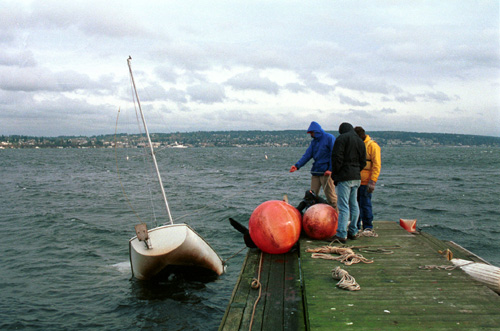
All of us were able to pull the boat into the dock by hauling on the line.
This was much easier than we had anticipated and we had expected to have to set up a purchase system or use come alongs to move the boat.
When we got the boat along side the dock I raised the bow by running a line from the two giant buoys, through a carabiner at the jib tack, and back to the jib sheet winch.
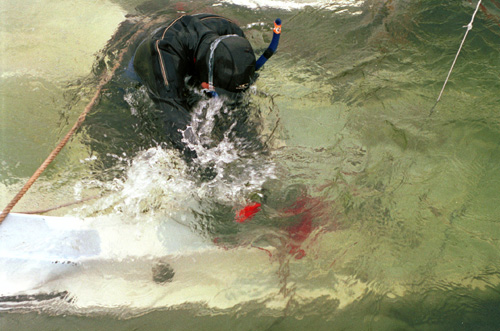
We had the boat floating awash enough to move it closer to shore and out of most of the wave action.
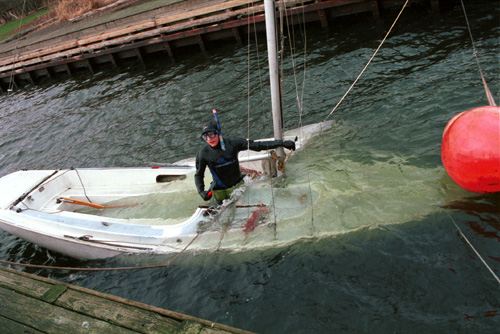
We turned the boat 90 degrees so that it was moored between the two docks with the bow at one and the stern at the other.
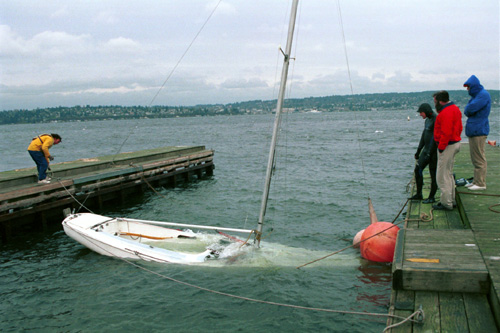
We lowered the bow down and attached the winch line to the dock.
Were able to winch the bow back up to the surface and had the boat awash.
The headstay turnbuckle broke during the process and we had to tie the jib halyard to the bow to keep the mast up.
We removed all the sails and loose rigging at this point.
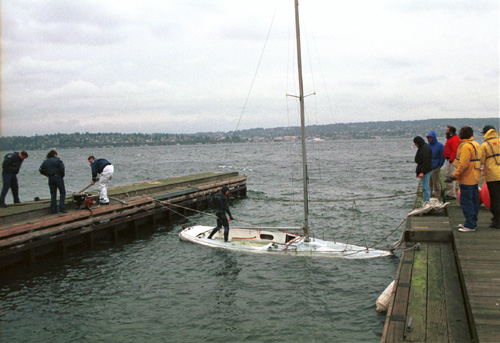
The next step in the process was to dewater the boat.
We were concerned about the water washing back in the companion way as fast as we could pump it out.
We wanted to place the hatchboards in place to prevent this but were unable to locate them.
Three officers from the Harbor Patrol drove over with a pair of 250 GPM pumps. They were able to dewater the boat in about three minutes using just one of the pumps.
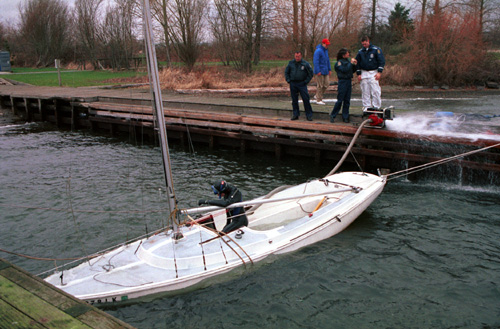
By about 4:30 we had a floating boat.
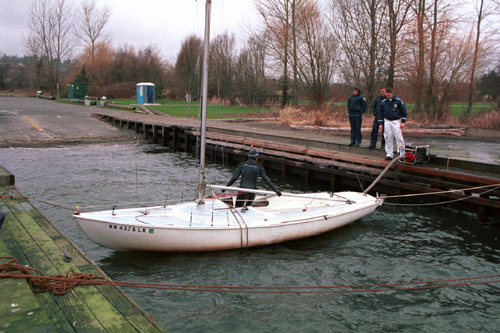
While I was changing out of my drysuit Tom started to tow the boat back with the small barge.
As I came out from changing I saw him motoring off with Chris in the Catalina. I went to get a bailing bucket for Chris and when I returned he was on the dock and the boats were leaving.
The Catalina was not tracking behind the barge very well and yawing off to the side because there wasn’t anybody steering. Tom was able to make progress to windward after he stopped and led the towline, which had been tied to the mast, to through a carabiner at the bow. When we got to the WAC a party went out on Came to Believe to check on Tom. All were back and secure at the WAC by about 6:00 when we retired to CTB for a cup of tea. Several of us then proceeded to Big Time for beer and food with the boat safely recovered.
